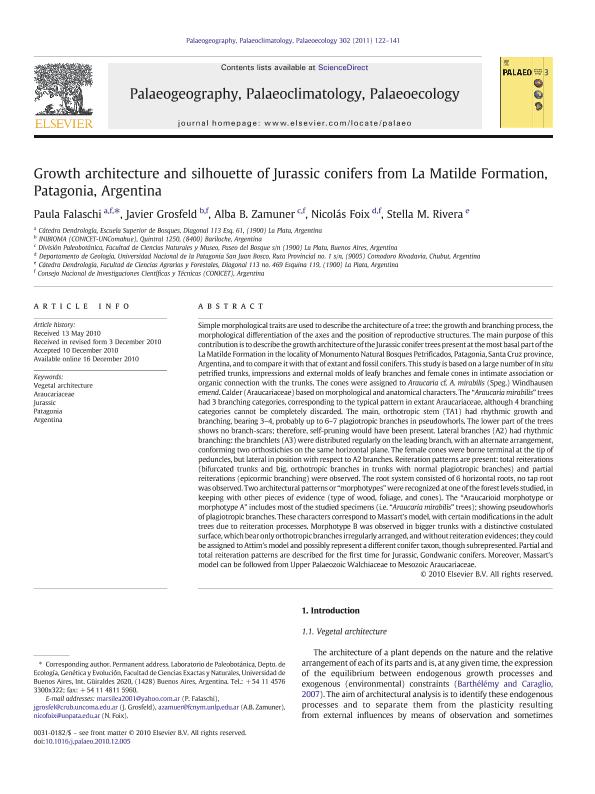Mostrar el registro sencillo del ítem
dc.contributor.author
Falaschi, Paula

dc.contributor.author
Grosfeld, Javier Edgardo

dc.contributor.author
Zamuner, Alba Berta

dc.contributor.author
Foix, Nicolas

dc.contributor.author
Rivera, Stella M.
dc.date.available
2019-01-22T18:43:46Z
dc.date.issued
2011-03
dc.identifier.citation
Falaschi, Paula; Grosfeld, Javier Edgardo; Zamuner, Alba Berta; Foix, Nicolas; Rivera, Stella M.; Growth architecture and silhouette of Jurassic conifers from La Matilde Formation, Patagonia, Argentina; Elsevier Science; Palaeogeography, Palaeoclimatology, Palaeoecology; 302; 3-4; 3-2011; 122-141
dc.identifier.issn
0031-0182
dc.identifier.uri
http://hdl.handle.net/11336/68407
dc.description.abstract
Simple morphological traits are used to describe the architecture of a tree: the growth and branching process, the morphological differentiation of the axes and the position of reproductive structures. The main purpose of this contribution is to describe the growth architecture of the Jurassic conifer trees present at the most basal part of the La Matilde Formation in the locality of Monumento Natural Bosques Petrificados, Patagonia, Santa Cruz province, Argentina, and to compare it with that of extant and fossil conifers. This study is based on a large number of in situ petrified trunks, impressions and external molds of leafy branches and female cones in intimate association or organic connection with the trunks. The cones were assigned to Araucaria cf. A. mirabilis (Speg.) Windhausen emend. Calder (Araucariaceae) based on morphological and anatomical characters. The "Araucaria mirabilis" trees had 3 branching categories, corresponding to the typical pattern in extant Araucariaceae, although 4 branching categories cannot be completely discarded. The main, orthotropic stem (TA1) had rhythmic growth and branching, bearing 3-4, probably up to 6-7 plagiotropic branches in pseudowhorls. The lower part of the trees shows no branch-scars; therefore, self-pruning would have been present. Lateral branches (A2) had rhythmic branching: the branchlets (A3) were distributed regularly on the leading branch, with an alternate arrangement, conforming two orthostichies on the same horizontal plane. The female cones were borne terminal at the tip of peduncles, but lateral in position with respect to A2 branches. Reiteration patterns are present: total reiterations (bifurcated trunks and big, orthotropic branches in trunks with normal plagiotropic branches) and partial reiterations (epicormic branching) were observed. The root system consisted of 6 horizontal roots, no tap root was observed. Two architectural patterns or "morphotypes" were recognized at one of the forest levels studied, in keeping with other pieces of evidence (type of wood, foliage, and cones). The "Araucarioid morphotype or morphotype A" includes most of the studied specimens (i.e. "Araucaria mirabilis" trees); showing pseudowhorls of plagiotropic branches. These characters correspond to Massart's model, with certain modifications in the adult trees due to reiteration processes. Morphotype B was observed in bigger trunks with a distinctive costulated surface, which bear only orthotropic branches irregularly arranged, and without reiteration evidences; they could be assigned to Attim's model and possibly represent a different conifer taxon, though subrepresented. Partial and total reiteration patterns are described for the first time for Jurassic, Gondwanic conifers. Moreover, Massart's model can be followed from Upper Palaeozoic Walchiaceae to Mesozoic Araucariaceae.
dc.format
application/pdf
dc.language.iso
eng
dc.publisher
Elsevier Science

dc.rights
info:eu-repo/semantics/openAccess
dc.rights.uri
https://creativecommons.org/licenses/by-nc-nd/2.5/ar/
dc.subject
Araucariaceae
dc.subject
Argentina
dc.subject
Jurassic
dc.subject
Patagonia
dc.subject
Vegetal Architecture
dc.subject.classification
Paleontología

dc.subject.classification
Ciencias de la Tierra y relacionadas con el Medio Ambiente

dc.subject.classification
CIENCIAS NATURALES Y EXACTAS

dc.title
Growth architecture and silhouette of Jurassic conifers from La Matilde Formation, Patagonia, Argentina
dc.type
info:eu-repo/semantics/article
dc.type
info:ar-repo/semantics/artículo
dc.type
info:eu-repo/semantics/publishedVersion
dc.date.updated
2019-01-22T15:08:43Z
dc.journal.volume
302
dc.journal.number
3-4
dc.journal.pagination
122-141
dc.journal.pais
Países Bajos

dc.journal.ciudad
Amsterdam
dc.description.fil
Fil: Falaschi, Paula. Universidad Nacional de La Plata. Facultad de Ciencias Agrarias y Forestales; Argentina. Consejo Nacional de Investigaciones Científicas y Técnicas; Argentina
dc.description.fil
Fil: Grosfeld, Javier Edgardo. Consejo Nacional de Investigaciones Científicas y Técnicas. Centro Científico Tecnológico Conicet - Patagonia Norte. Instituto de Investigaciones en Biodiversidad y Medioambiente. Universidad Nacional del Comahue. Centro Regional Universidad Bariloche. Instituto de Investigaciones en Biodiversidad y Medioambiente; Argentina
dc.description.fil
Fil: Zamuner, Alba Berta. Universidad Nacional de La Plata. Facultad de Ciencias Naturales y Museo. Área Paleobotánica; Argentina. Consejo Nacional de Investigaciones Científicas y Técnicas; Argentina
dc.description.fil
Fil: Foix, Nicolas. Universidad Nacional de la Patagonia "San Juan Bosco". Facultad de Ciencias Naturales - Sede Comodoro. Departamento de Geología; Argentina. Consejo Nacional de Investigaciones Científicas y Técnicas; Argentina
dc.description.fil
Fil: Rivera, Stella M.. Universidad Nacional de La Plata. Facultad de Ciencias Agrarias y Forestales; Argentina
dc.journal.title
Palaeogeography, Palaeoclimatology, Palaeoecology

dc.relation.alternativeid
info:eu-repo/semantics/altIdentifier/doi/http://dx.doi.org/10.1016/j.palaeo.2010.12.005
dc.relation.alternativeid
info:eu-repo/semantics/altIdentifier/url/https://www.sciencedirect.com/science/article/pii/S0031018210007108
Archivos asociados
